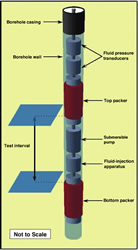|
The U.S. Geological Survey (USGS) Toxic Substances
Hydrology Program develops field methods to
measure a wide range of environmental properties, and develops
approaches and protocols used to assess or characterize
contamination.
The Program also develops laboratory analytical methods to measure a wide variety of chemicals in environmental media.
|

A diagram of the BAT3 in a bedrock borehole with borehole packers inflated to seal against the borehole wall. The length of the test interval is adjusted by adding additional sections of pipe between the fluid-injection apparatus and the bottom packer. The BAT3 is lowered or raised in the borehole using steel pipe or a cable attached above the transducer shrouds -- from the BAT3 Photo Gallery/afs/.usgs.gov/www/toxics/htdocs/photo_gallery/benthic_flux.html -- from the Benthic Flux of Dissolved Metals Photo Gallery
Bibliography
|